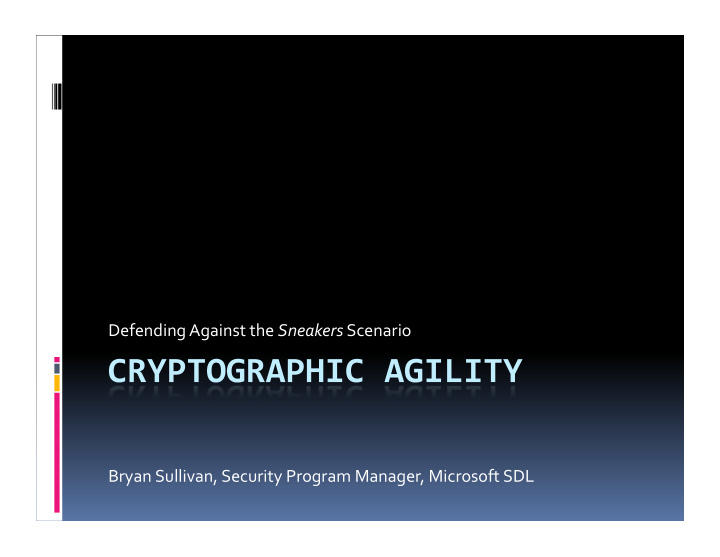



Defending Against the Sneakers Scenario Bryan Sullivan, Security Program Manager, Microsoft SDL
Crypto systems get broken eh vxuh wr gulqn brxu rydowlqh be sure to drink your ovaltine Why assume that current algorithms really are unbreakable, unlike every other time in the history of cryptography?
Consequences Change code Rebuild Retest Deploy patches to n users Pretty big window of attack…
Other concerns Export controls International regulations FIPS‐140
Solution Plan for this from the beginning Assume the crypto algorithms you use will be defeated in your application’s lifetime Code your apps in a cryptographically agile manner Or code‐review apps for crypto agility if you’re of the pentester persuasion and not a dev
Steps toward crypto agility Step 1: Avoid hardcoded algorithms
Abstraction Want one of these? Are you sure?
Three Cryptographically Agile Frameworks * .NET JCA CNG Java Cryptography Cryptography API Architecture Next Generation *If used correctly…
.NET Cryptography
.NET top‐level abstract classes SymmetricAlgorithm AsymmetricAlgorithm HashAlgorithm KeyedHashAlgorithm HMAC RandomNumberGenerator
.NET Crypto Architecture HashAlgorithm +ComputeHash() #HashCore() +Create() SHA512 SHA1 SHA512Managed SHA512Cng SHA1Managed
.NET examples Non‐agile: MD5Cng hashObj = new MD5Cng(); byte[] result = hashObj.ComputeHash(data);
.NET examples More agile: HashAlgorithm hashObj = HashAlgorithm.Create("MD5"); byte[] result = hashObj.ComputeHash(data);
Java Cryptography Architecture (JCA)
JCA top‐level classes javax.crypto.Cipher javax.crypto.KeyAgreement java.security.KeyFactory javax.crypto.KeyGenerator java.security.KeyPairGenerator javax.crypto.Mac java.security.MessageDigest javax.crypto.SecretKeyFactory java.security.SecureRandom java.security.Signature
JCA Architecture MessageDigestSpi +engineDigest() MessageDigest DigestBase +digest() +getInstance() MD5 SHA SHA2
JCA example More agile (by default, this is great!): MessageDigest md = MessageDigest.getInstance("MD5"); byte[] result = md.digest(data);
JCA Architecture MessageDigestSpi +engineDigest() MessageDigest DigestBase +digest() +getInstance() MD5 SHA SHA2
Cryptography API: Next Generation (CNG)
CNG agile capabilities Key generation and exchange Object encoding and decoding Data encryption and decryption Hashing and digital signatures Random number generation
CNG Architecture BCRYPT_HASH_INTERFACE +GetHashInterface() BCRYPT_HASH_FUNCTION_TABLE BCRYPT_HASH_INTERFACE +Version +OpenAlgorithmProvider +GetProperty HashProvider +SetProperty +CloseAlgorithmProvider +CreateHash +HashData +FinishHash +DuplicateHash +DestroyHash
CAPI example Non‐agile: HCRYPTPROV hProv = 0; HCRYPTHASH hHash = 0; CryptAcquireContext(&hProv, NULL, NULL, PROV_RSA_FULL, 0); CryptCreateHash(hProv, CALG_MD5, 0, 0, &hHash); CryptHashData(hHash, data, len, 0);
CNG example More agile: BCRYPT_ALG_HANDLE hAlg = 0; BCRYPT_HASH_HANDLE hHash = 0; BCryptOpenAlgorithmProvider(&hAlg, "MD5", NULL, 0); BCryptCreateHash(hAlg, &hHash, …); BCryptHashData(hHash, data, len, 0);
Still looks hardcoded to me… .NET HashAlgorithm.Create("MD5"); JCA MessageDigest.getInstance("MD5"); CNG BCryptOpenAlgorithmProvider(&hAlg, "MD5", NULL, 0);
Steps toward crypto agility Step 1: Avoid hardcoded algorithms Step 2: Reconfigure the algorithm provider
JCA Provider Framework Application Provider Framework SHA‐1 MD5 MD5 SHA‐256 SHA‐1 SHA‐512 Provider A Provider B Provider C
JCA Provider Framework MessageDigest. Application getInstance ("MD5"); Provider Framework SHA‐1 MD5 MD5 SHA‐256 SHA‐1 SHA‐512 Provider A Provider B Provider C
JCA Provider Framework MessageDigest. Application getInstance ("MD5", "Provider C"); Provider Framework SHA‐1 MD5 MD5 SHA‐256 SHA‐1 SHA‐512 Provider A Provider B Provider C
Configure providers Option #1: Modify java.security file (static) security.provider.1= sun.security.provider.Sun security.provider.2= sun.security.provider.SunJCE …
Configure providers Option #2: Add in code (dynamic) java.security.Provider provider = new MyCustomProvider(); Security.addProvider(provider);
Scenario #1: Bad provider security.provider.1=foo security.provider.2=bar
Scenario 2: Bad algorithm Application Provider Framework SHA‐1 MD5 MD5 “MD5” SHA‐256 SHA‐1 SHA‐512 Provider A Provider B Provider C New Custom Provider
Custom provider public class Provider extends java.security.Provider { put("MessageDigest.MD5", "MyFakeMD5Implementation"); }
JCA Architecture MessageDigestSpi +engineDigest() MessageDigest DigestBase +digest() +getInstance() MD5 SHA SHA2
Fake implementation MessageDigestSpi +engineDigest() FakeMD5Implementation SHA +digest()
CNG provider framework Similar to JCA, but less flexible Custom providers go in system folder Must register programmatically Can only specify top or bottom of the list
Fake implementation BCRYPT_HASH_INTERFACE +GetHashInterface() BCRYPT_HASH_FUNCTION_TABLE BCRYPT_HASH_INTERFACE +Version +OpenAlgorithmProvider +GetProperty FakeMD5Implementation +SetProperty +CloseAlgorithmProvider +CreateHash +HashData +FinishHash +DuplicateHash +DestroyHash
Registering a custom provider CRYPT_PROVIDER_REG providerReg = {…}; BCryptRegisterProvider( "FakeMD5Implementation", 0, &providerReg); BCryptAddContextFunctionProvider( CRYPT_LOCAL, NULL, BCRYPT_HASH_INTERFACE, "MD5", "FakeMD5Implementation", CRYPT_PRIORITY_TOP);
Avoid hardcoded implementation BCRYPT_ALG_HANDLE hAlg = 0; BCryptOpenAlgorithmProvider( &hAlg, "SHA1", "Microsoft Primitive Provider", 0);
.NET Application HashAlgorithm. Create("MD5") mscorlib machine.config
Altering machine.config <configuration> <mscorlib> <cryptographySettings> <nameEntry name="MD5" class="MyPreferredHash" /> <cryptoClasses> <cryptoClass MyPreferredHash="SHA512Cng, …" /> </cryptoClasses>
Remapping algorithm names is dangerous MD5 SHA‐1 This is a good thing, right? What could possibly go wrong?
Steps toward crypto agility Step 1: Avoid hardcoded algorithms Step 2: Avoid hardcoded implementations Step 3: Reconfigure the algorithm provider Step 3 (alternate): Avoid default algorithm names
Unique algorithm names .NET HashAlgorithm.Create( "ApplicationFooPreferredHash"); JCA MessageDigest.getInstance( "ApplicationBarPreferredDigest"); CNG BCryptOpenAlgorithmProvider(&hAlg, "ApplicationFooPreferredHash", …);
Steps toward crypto agility Step 1: Avoid hardcoded algorithms Step 2: Avoid hardcoded implementations Step 3: Reconfigure the algorithm provider Step 3 (alternate): Avoid default algorithm names Step 3 (alternate #2): Pull algorithm name from secure configuration store
Unique provider vs. config Unique provider Configuration store Pros Pros Much easier to Security to perform this implement action already part of the system Cons Cons Probably prohibitive in Must remember to terms of secure the store! implementation cost
What went wrong? Changing the algorithms is one thing… …but changing stored data is another.
Steps toward crypto agility Step 1: Avoid hardcoded algorithms Step 2: Avoid hardcoded implementations Step 3: Reconfigure the algorithm provider Step 3 (alternate): Avoid default algorithm names Step 3 (alternate #2): Pull algorithm name from secure configuration store Step 4: Store and consume algorithm metadata
What metadata to store Hashes Algorithm name Salt size Output size (Max input size) Size considerations Local variables (ie source code) Database columns
What metadata to store Symmetric encryption Algorithm name Block size Key size Mode Padding mode Feedback size
What metadata to store Asymmetric encryption Algorithm name Key sizes Key exchange algorithm Signature algorithm
What metadata to store MAC Algorithm name Key size Key derivation function Function algorithm Salt size Iteration count Output size (Max input size)
MS‐OFFCRYPTO Office Document Cryptography Structure Specification http://msdn.microsoft.com/en‐us/library/ cc313071(office.12).aspx
Recommend
More recommend